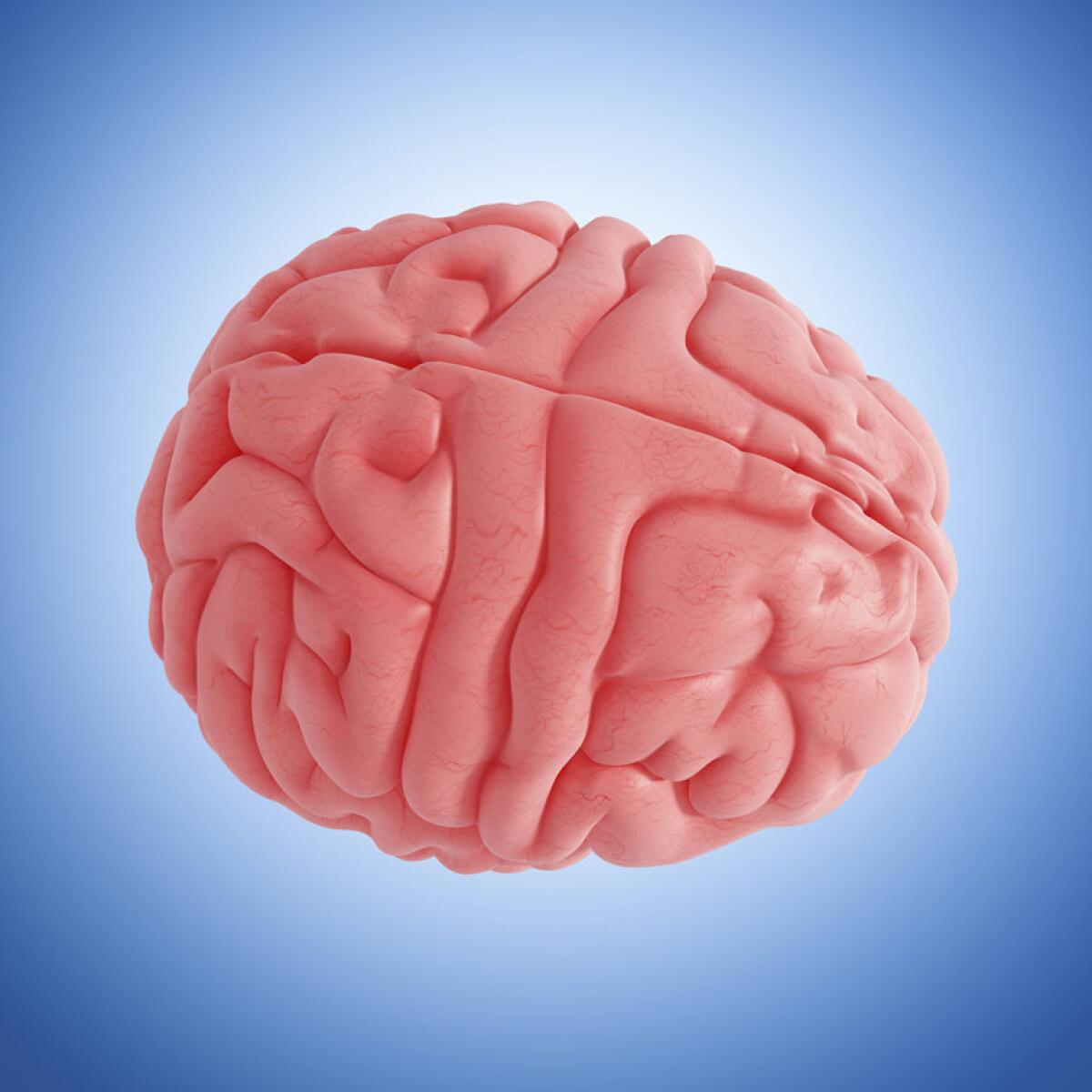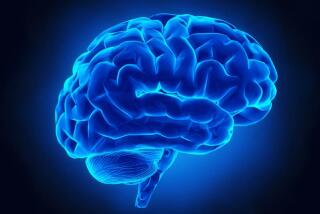Op-Ed: My aging brain makes me feel stupid

The human brain: the size of Kareem Abdul-Jabbar’s fist and the consistency of flan.
Meet my brain. It is the size of Kareem Abdul-Jabbar’s fist, the consistency of flan, weighs as much as a two-slice toaster and looks like ground round with a high fat content. If you saw it at the butcher’s, you’d ask for something a little less beige.
If you were a plastic surgeon, you’d say my brain needed a facelift. The reason my brain is so wrinkly and ridged is that, like a suitcase packed with a lot of junk, it contains too many neurons to fit smoothly inside my skull.
Of late I’ve been a bit worried about my brain. When I ask it a simple question like “What is the word for that thing that’s sort of a harmonica but more annoying and looks like you could smoke pot with it?” or when I look for my glasses while wearing my glasses, I think, “My, my, it’s going to be a very smooth transition to dementia.”
How is it that certain minds seem able to forestall senescence, while others succumb?
You may have read in some magazine whose name I can’t recall that we can affect the resilience of our brains by investing in it early on, banking mental health as if in a 401(k) — to borrow an analogy from the psychologist Sherrie All. This notion hinges on the widely accepted theories of brain reserve and cognitive reserve.
Kenneth Kosik, a neurologist and neuroscience professor at UC Santa Barbara, explained these two kindred concepts to me during a rapid discourse that he called “The History of Alzheimer’s in Thirty Seconds,” which lasted about half an hour.
Here’s the short version: In 1988, autopsies of several elderly people revealed the plaques and tangles associated with Alzheimer’s disease. However, these individuals, during their lifetimes, had displayed no signs of dementia. It has been hypothesized that they’d been buffered from the effects of the disease by the extra neuronal capacity that they had been born with (brain reserve) or accrued through years of intellectual and physical pursuits (cognitive reserve).
Similarly, a study that analyzed the essays written by 678 elderly nuns when they were in their twenties found that the sisters who had used the most linguistically complex sentences were the least likely to have Alzheimer’s, which is why I’ve added this unnecessary subordinate clause even though it’s been a long time since I was in my twenties.
The damage to the brain caused by Alzheimer’s can be compared to traffic jams caused by tractor-trailer accidents. Someone who has a robust neural network can find ways around these obstructions using back roads.
But not forever. Unless you have the good luck to kick the bucket before your roadways become disastrously clogged up, sooner or later, even you, with your clever compensatory strategies, will have difficulty getting from here to there.
Paradoxically, those with higher IQs, more education or higher occupation achievement deteriorate faster than average once they show symptoms of Alzheimer’s disease. To wit (if I may use that phrase), researchers found that every year of education postpones the memory failure associated with dementia by 2 1/2 months, but once the pathology becomes apparent, the rate of diminishment is 4% faster.
But back to my ol’ noggin. What would it take to — poof — transform it into a spiffy young noggin? For four months, I crammed my days and nights with as many brain-boosting pursuits as I could stand.
For example, I learned Cherokee, zapped electricity into my brain, meditated, did online brain exercises and, for one day, gave up Diet Coke. Before and after my Smartification Program, I had my brain imaged and my IQ taken. Did I get less stupid?
I can’t reveal that secret. Actually I can, it’s on Page 182 of my new book. But here is a list of self-improvement endeavors that purportedly vitalize your mind. I have culled them from various books and websites. Some I have invented. Can you figure out which ones are bona fide? (Answer “real” or “fake.”)
How to Be Brainier
1. Write backward with your weaker hand.
2. Rearrange your furniture.
3. Make your bed using the flat sheet for the fitted sheet and vice versa.
4. Create “top 100” lists.
5. Eat dinner under the table.
6. Parallel park while blindfolded.
7. Take a baked potato out of the oven with your bare hand.
8. Avoid reading the newspaper or news websites for a week.
9. Donate one-third of your clothes to charity.
10. Eat less.
11. Take ginkgo biloba.
12. Don’t take ginkgo biloba.
13. Sit up straight.
14. Wash behind your ears.
15. Take a nap.
16. Play Tetris.
17. Go to a black-tie affair wearing something red.
18. Get rid of toxins by gargling with prune juice.
19. File for a divorce.
20. Question everything. Ask why incessantly.
ANSWERS:
1. (R)
2. (R)
3. (F)
4. (R)
5. (F)
6. (F)
7. (F)
8. (F)
9. (F)
10. (R)
11. (R)
12. (R)
13. (R)
14. (F)
15. (R)
16. (R)
17. (F)
18. (F)
19. (F)
20. (R)
Patricia Marx is a former “Saturday Night Live” writer and New Yorker staffer. This essay was excerpted from her book “Let’s Be Less Stupid: An Attempt to Maintain My Mental Faculties.”
Follow the Opinion section on Twitter @latimesopinion and Facebook
More to Read
A cure for the common opinion
Get thought-provoking perspectives with our weekly newsletter.
You may occasionally receive promotional content from the Los Angeles Times.










